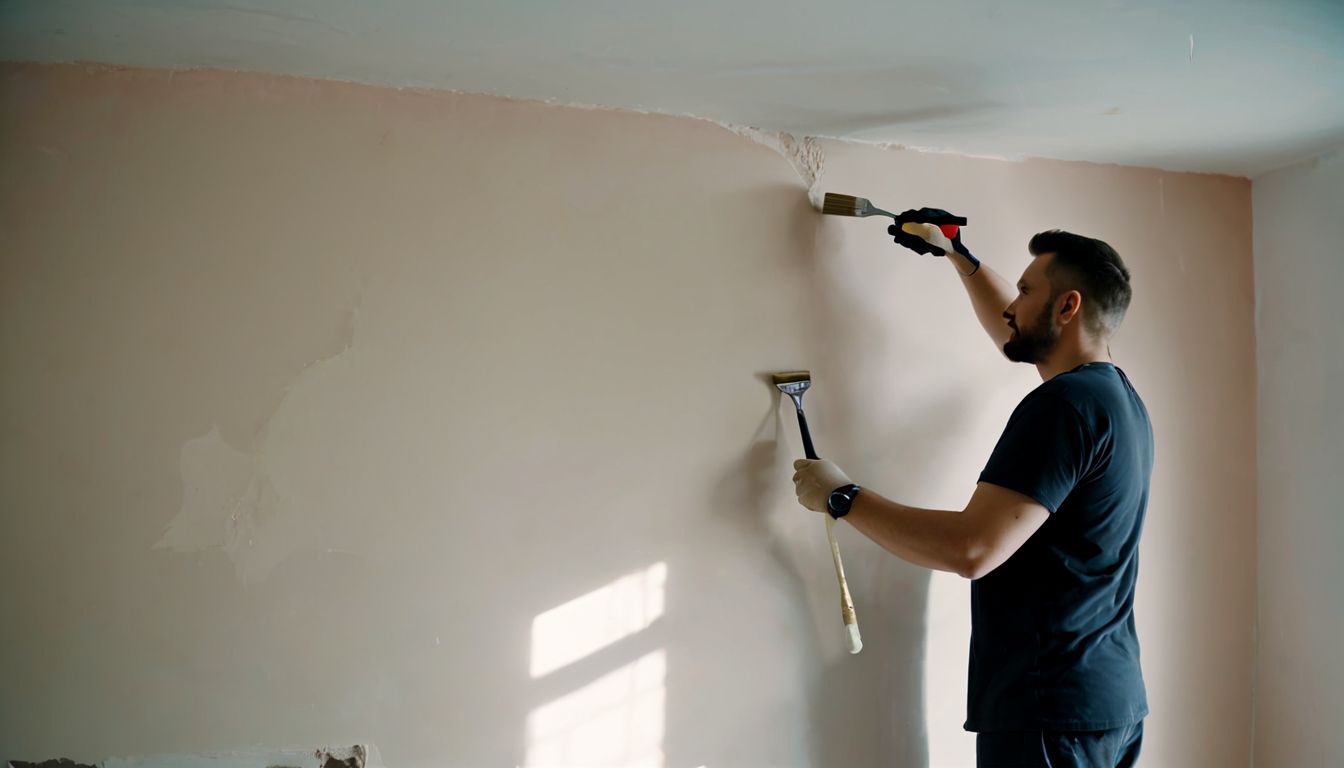
Plastering your interior walls gives you a smooth, blank canvas to paint onto. However, before you load up your brush or roller, it’s important to know how to paint plastered walls. It may seem like a simple job but getting it wrong can be costly.
So what is the best paint for plaster? Don’t worry, we’re here to help.
Key Takeaways
- Make sure the plaster has fully dried before you begin painting or priming.
- There are a wide range of paints to choose from including emulsion, oil-based, acrylic, and more!
- You should either use a mist coat or Paintmaster contract emulsion before you apply a topcoat.
- Follow our guide for the best results!
Painting Plastered Walls
Coating walls with plaster first is a must for many decorating projects. Without it a wall’s rough textures will show through even multiple layers of thick paint, whereas plaster is completely smooth if applied correctly and can be sanded for an even better finish.
If your walls have been recently plastered, you need to give them enough time to dry. They will be touch dry after a couple of days, but don’t be fooled. If you apply paint too soon, the moisture in the plaster will cause the paint to flake away and you’ll be back to square one. Here’s how long to wait before painting plaster:
Make sure the plaster has been left to dry for a few weeks before you begin painting.
There is one type of paint that can be used on plastered walls before the drying time has passed. Contract matt paint is designed for use on damp plaster. It is permeable, allowing the plaster to breathe through a single coat. This type of paint also acts as a primer for other types of paint; you should still paint the walls properly when the plaster is dry.
This is a solution for anyone who needs to paint the walls as soon as possible, such as landlords, but for everyone else it’s worth waiting the four weeks.
What is the Best Paint for Plaster?
The most popular type of paint for interior walls is emulsion. They are beginner-friendly and offer great coverage. Available in a wide range of colours and hues, emulsion paint is a great choice for painting plastered walls. Emulsion paint is required for a ‘mist coat’ too, so it often makes the most sense to use it for the topcoat as well.
However, emulsion is not the only paint option. For more experienced painters, oil-based paints can create amazing results. They are naturally more durable than emulsion, with UV protection that reduces fading and a resistance to scuffs that few other paints offer. Oil-based paints look better for longer but can be tricky to apply if you’re new to painting and cleanup requires mineral spirits instead of the usual soap and water.
As is often the case with interior painting, there is an acrylic option too. The primary benefit is that acrylic paint is non-toxic, which is an important factor for many people. It also dries faster than other types of paint (around 30 minutes per layer on average) which is excellent if you have limited decorating time. Acrylic also has a huge range of colours to choose from; if you have a specific colour in mind for your walls, you’ll be able to find acrylic that matches.
Masonry paint can also be used on plastered walls and is often the best choice if the plaster surface is rougher. This saves time and effort sanding, which is recommended before you apply other types of paint.
All of these options are available as part of our Colour System. This means that we can create any colour you can imagine for your walls. Simply enter an RAL or British Standard code and your paint will be ready to order.
How to Paint Plastered Walls – Plaster Painting Guide
Once you’ve chosen the perfect paint in the perfect colour, and your plaster is fully dried, it’s time to get to work.
If the surface of your plaster is rough, you may want to consider sanding out the imperfections before you paint. This isn’t essential, but keep in mind that the roughness will show through even multiple layers of topcoat.
You can also mix a ‘mist coat’ for your first layer, which needs to be emulsion, instead of the usual water-based primer. We’ll explain how to do this in time, so be sure to read all the steps before you get started so there are no surprises or delays.
Here’s what you’ll need to paint your plaster:
- Emulsion Paint (for the Mist Coat) or Contract Matt
- Your Chosen Paint (or more Emulsion Paint)
- Paintbrush or Roller
- Dust Sheets
- Water
- Decorator’s or Masking Tape
- Sandpaper*
*If you decide to smooth the surface of the plaster
STEP 1 – Preparing a Plastered Wall for Painting
If your plaster is new, there is no need to clean the surface unless it has gathered a lot of dust or grime while drying. If it’s older, a cloth and a mild soapy detergent will do the trick. Allow plenty of drying time if you do clean your walls.
When you’re satisfied with the surface (after sanding or cleaning), clear away furniture and anything else blocking the walls, and cover the floors and anything that can’t be removed with your dust sheets. Cover as much area as possible to avoid having to clean up splashes afterwards.
You should also mark the edges of your walls with the masking or decorator’s tape. This will prevent overlap onto ceilings and floors and give you those professional sharp edges.
STEP 2 – Mist Coat or Priming Plaster Walls
Next, it’s time to mix and apply a mist coat to your walls.
The mist coat consists of watered-down emulsion. The extra moisture is absorbed by the dry plaster and acts as a primer to help the topcoat stick better. This leads to bolder colours and an even finish.
If you don’t want to apply a mist coat, a water-based primer will have the same affect.
Apply an even layer of mist coat or primer to the wall, being careful to overlap each stroke to avoid leaving any gaps. You can use a roller or brush for this; a roller can make more mess, but it is quicker overall, a brush can help you access any tricky areas.
The watered-down paint will run more easily, be sure to paint over any runoff to prevent streaks.
Leave that layer to dry before moving on. Consult the tin for drying times.
STEP 3 – Painting a Plastered Wall
Now for the fun part.
Once you have a layer of primer, the surface can be painted like any other. Apply even streaks with your brush and roller, overlapping each once again.
You should only need two layers of topcoat for the best results, but some thicker paints only need one. Be sure to check the manufacturer’s recommendations before you commit.
STEP 4 – Admire your Painted Plaster
Once the final layer has dried, take a step back and admire your freshly painted walls. How do they look?
If the surface was prepped properly, the surface should be smooth and looking great.
The UK’s Most Trusted Paint Supplier
Painting interior walls is one of the most satisfying painting projects you can do. If the surface has been freshly plastered, it becomes even more fun for beginners and professionals and will make the room look fantastic.
We’re the no.1 choice for tradespeople, with large quantities of paint available at competitive prices, and we’re loved by domestic painters too!
Check out our blog for more information, advice and guides about all things painting. If you have any questions about any of our products, please get in touch.
We look forward to hearing from you.
FAQ's
Can you paint directly over old plaster?
You should only paint onto old plaster if it isn’t flaking or cracked. If it is in poor condition, you should repair and/or use sandpaper before you begin painting. Any imperfections in the surface will show through even multiple layers of paint.
Do I need to prime plaster before painting?
By priming the plaster before adding paint, you create an extra layer of protection, extending the lifespan of your walls. Primer also helps colours to look bolder, and the sheen to last longer.
Do I need to sand plaster before painting?
If your plastered walls are rough, with spots and bumps, it’s recommended to sand these away before adding paint and primer. If ignored, they will show through your paint, ruining the look of your walls, so inspect the surface thoroughly before you commit.
Is a mist coat the same as primer?
A mist coat of emulsion paint acts as a primer for the topcoat, adding extra protection and making colours stand out more. The plaster absorbs this initial layer, creating an ideal surface to paint onto.
Is it OK to paint straight onto plaster?
As long as the plaster has fully dried, it’s safe to paint onto. Make sure you give it plenty of time to dry, just because it’s dry to the touch doesn’t mean it’s ready for painting. If your home is a new build, you should leave your plaster for 4-6 weeks to fully settle. Adding a layer of primer before you paint is also recommended.
What kind of paint do you use on plaster?
Once the plaster has fully dried, a coat of emulsion paint, acrylic paint, or oil-based paint will make your walls look amazing. Masonry paint can also be used but is best for rough walls that you’d have to sand otherwise.
